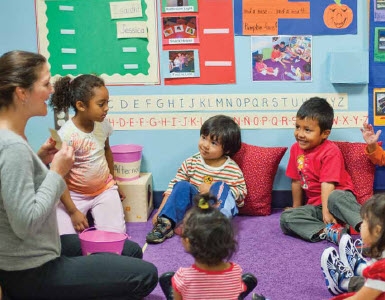
One in every four children in the United States under the age of five is Hispanic, a growth rate that is predicted to continue multiplying in the coming decade. In states such as California, Hispanics make up more than half of all school children enrolled in public schools. While the population of Latino children in the school system has significantly increased, many of the schools educating our nation’s youngest students may still lag behind in developing quality measures that ensure they are addressing the needs of this culturally and linguistically diverse population.
This approach would have a significant impact on Latinos, who are among the children least likely to have a preschool experience before kindergarten. In 2009, only 48 percent of Hispanic four-year-olds attended preschool, compared to 70 percent of White and 69 percent of Black children of the same age.
This lack of preschool participation contributes to the school-readiness gap and to future educational disparities. For example, a California study documented that Latino children start kindergarten already two months behind White students in reading and math skills. Clearly, any attempt to equalize educational outcomes for Latinos must begin well before kindergarten.
Almost three-fifths (59 percent) of Latino children live in low-income families, which puts them at risk for poor educational outcomes. Low levels of maternal education are also associated with low levels of school readiness and poor language acquisition, and Hispanic children are more likely than their peers to live in a household with a mother who did not graduate from high school.
In 2008, for example, 42 percent of Latino children lived with a mother who did not complete high school, compared to 25 percent of Black children and 10 percent of White children. This may partially explain why, by age two, Latino children are already behind White children in vocabulary and problem-solving skills. Hispanic children also represent a large proportion (80 percent) of the nation’s English language learners. Among Latino students, nearly two-fifths are ELLs, and the majority of ELLs (65 percent) are native-born citizens.
These students often require additional support to succeed academically, but the quality and effectiveness of education programs varies widely.
Furthermore, Hispanic children are concentrated in schools that primarily serve low-income students and have fewer available resources. In 2003–2004, one-third of Hispanic children were enrolled in high-poverty schools. Latinos account for 46 percent of all students attending school in high-poverty urban areas.
In 2009, 39 percent of Latino eighth graders scored “below basic” in reading, and 43 percent scored “below basic” in mathematics, compared to 16 percent and 17percent of White students, respectively. Additionally, only 55 percent of Hispanic students who enter ninth grade graduate on time with a traditional diploma.
Source: National Council of La Raza, “Preschool education: Delivering on the promise for Latino children”, September 2011.